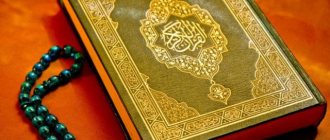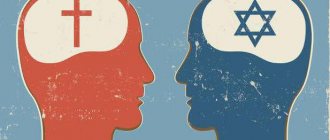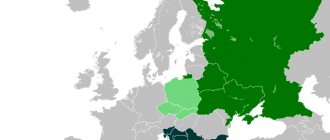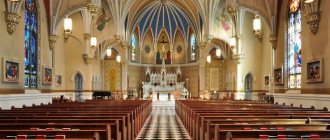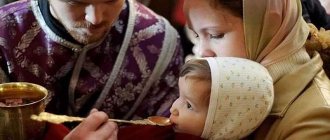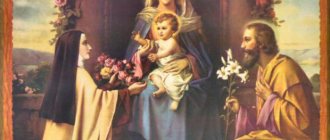Structure of the Catholic Church
Faith of the Roman Catholic Church
The doctrine of the Catholic Church is set out in the Nicene-Constantinople Creed and is revealed in the decisions of the first seven Ecumenical Councils, as well as councils held later on the initiative of the Pope.
In the main issues of doctrine, Catholicism has much in common with Orthodoxy, but there are also differences. Here are the main ones. The Roman Catholic Church teaches that there is one eternal God in three persons: God the Father, God the Son (Jesus Christ) and God the Holy Spirit. Catholic dogma is given in the Nicene Creed and described in detail in the Catechism of the Catholic Church. The Catholic faith declares that the Church "...is the continuing presence of Jesus on earth." The Church teaches that salvation exists only in the Catholic Church, but recognizes that the Holy Spirit can use Christian communities to bring people to salvation.
Hierarchy of the Roman Catholic Church
The head of the Church is the Pope.
As in all other historical churches, the priestly hierarchy is clearly separated from the laity, and is divided into three degrees of priesthood:
- bishop;
- priest.
- deacon
The hierarchy of the clergy includes numerous ecclesiastical degrees and offices (see Ecclesiastical degrees and offices in the Roman Catholic Church), as an example:
- cardinal;
- archbishop;
- primate;
- Metropolitan;
- prelate;
- abbot;
There are also the offices of Ordinary, Vicar, and Coadjutor—the latter two offices involving the function of a deputy or assistant, such as a bishop. Members of monastic orders are sometimes called regular (from the Latin regula - rule) clergy, but the majority, appointed by the bishop, are diocesan, or secular. Territorial units can be:
- diocese (diocese);
- archdiocese (archdiocese);
- apostolic administration;
- apostolic prefecture;
- Apostolic Exarchate;
- Apostolic Vicariate;
- Territorial Abbey;
Each territorial unit consists of parishes, which can sometimes be grouped into deaneries. The union of dioceses and archdioceses is called a metropolitanate, the center of which always coincides with the center of the archdiocese. There are also military ordinariates serving military units. Particular Churches in the world, as well as various missions, have the status of “Sui iuris”.
Collegiality in the government of the Church (extra Ecclesiam NULLA salus) is rooted in apostolic times. The Pope exercises administrative authority in accordance with the Code of Canon Law and may consult with the World Synod of Bishops. Diocesial clergy (archbishops, bishops, etc.) act within the framework of ordinary jurisdiction, that is, associated by law with the office. A number of prelates and abbots also have this right, and priests within the limits of their parish and in relation to their parishioners.
Structure of the Catholic Church
The Pope of Rome has the highest, full, immediate, universal and ordinary authority in the Catholic Church. The advisory bodies under the pope are the College of Cardinals and the Synod of Bishops. The administrative apparatus of the Church is called the Roman Curia, which includes congregations, courts and other institutions. The episcopal see of the pope together with the curia form the Holy See, located in the independent state of Vatican City. The Holy See is a subject of international law.
The Universal Catholic Church consists of the Latin Rite Church and the Eastern Catholic Churches, which profess one of the Eastern liturgical rites and have the status of “sui iuris” (their right). In practice, this is expressed in the fact that these churches, while remaining in communion with the Pope and fully sharing Catholic dogma, have their own hierarchical structure and their own canon law. The largest Eastern Catholic churches are headed by a Patriarch or supreme archbishop. Eastern Patriarchs and supreme archbishops are equated to cardinal bishops of the Latin rite and occupy the place immediately behind the pope in the Catholic hierarchy.
The basic distinct territorial unit is the diocese, headed by a bishop. Some important dioceses have historically been called archdioceses. Other types of territorial units are equated to dioceses:
- apostolic vicariate
- apostolic prefecture
- apostolic administration
- military ordinariate
- territorial prelature
- territorial abbey
In the Eastern Catholic Churches, there are also exarchates.
Several dioceses (and archdioceses) may constitute a metropolitanate or an ecclesiastical province. The center of the metropolitanate necessarily coincides with the center of the archdiocese, thus the metropolitan in the Catholic Church is necessarily an archbishop. In some countries (Italy, USA, etc.) metropolises are united into ecclesiastical regions. The bishops of most countries are united in a conference of bishops, which has great powers in organizing the church life of the country.
Dioceses consist of parishes, which are headed by parish priests, subordinate to the bishop. The rector in the parish may be assisted by other priests, called vicars. Sometimes nearby parishes unite into deaneries.
A special role in the Catholic Church is played by the so-called institutions of consecrated life, that is, monastic orders and congregations; as well as the Society of Apostolic Life. Institutes of consecrated life have their own statutes (approved by the pope); their territorial organization does not always correspond to the diocesan structure of the church. Local units of monastic orders and congregations are sometimes subordinate to local diocesan bishops and sometimes directly to the pope. A number of orders and congregations have a single head (General of the Order, Superior General) and a clear hierarchical structure; others are amalgamations of completely autonomous communities.
Basilica of San Paolo fuori le Mura
This basilica is more than seventeen centuries old. The church received the name “St. Paul Outside the Walls” because of its location. It is located outside the Aurelian Wall, which by ancient Roman standards was considered outside the city limits. The grandeur of the cathedral is amazing - 80 columns support the basilica, and the ceiling is covered with sparkling gilding.
Along the gallery there are medallions with images of 236 pontiffs. Some of them have not yet been completed. According to legend, the end of the world will come when the last pontiff is filled. Relics of the cathedral: the relics of St. Paul, part of his staff and a particle of the Life-giving Cross of the Lord.
After the fire that destroyed the cathedral in 1823, building materials were brought from many countries. Malachite and lapis lazuli were brought from Tsarist Russia to decorate the altar. The opulence and grand size highlight St. Paul's role in spreading Christianity throughout the world.
Open every day until 18.30. Free admission. The monastery, art gallery and archaeological area are open until 18.15. The entrance ticket costs 4 euros.
How to get there:
The church is located at Piazzale di San Paolo 1. Metro line B, Basilica San Paolo station.
Catholic Church Rites
Features of the Catholic Church Rite
Catholic church rites have a number of features that distinguish them from Orthodox and Protestant rites. Priests and bishops of the Latin rite must take a vow of celibacy. In Orthodoxy, only monasticism gives a vow of celibacy.
In the 20th century, the institution of a permanent diacanate was restored; For permanent deacons, celibacy is not required, but such deacons will no longer be able to become priests.
In Eastern Catholic rites, celibacy is only mandatory for bishops.
The most common rite in the Catholic Church is Latin or Roman . Other Western rites are used only within the territory of a particular monastic order or city.
For example, certain differences from the Latin (Roman) rite are found in the Ambrosian (western Lombardy), Braga (Braga in Portugal), and also in the Mozarabic (Toledo in Spain) rites. Eastern rites are used in the worship of Eastern Catholic churches . For example, the Greek Catholic rite is used in the Eastern Catholic churches of Belarus, Slovakia, Hungary, Romania, Ukraine, in the churches of the Rusyns, and also in small quantities among Greeks, Bulgarians, Croats and Russians.
Divine services in the Latin rite until the Second Vatican Council (1962-1965) were traditionally performed in Latin.
Later, services began to be performed in national languages as well. The Liturgy of the Latin Rite or Mass is the main liturgical action in which the sacrament of the Eucharist (communion) is celebrated. The Mass consists of the Liturgy of the Word , the main element of which is the reading of the Bible, and the Eucharistic Liturgy .
The liturgical year begins with Advent , i.e. from the Nativity Fast and is divided into several periods: two fasting periods - Advent and Great Lent , two holiday periods - Christmas and Easter .
Sant'Andrea al Quirinale
This church is another outstanding project by Bernini, commissioned by the Jesuits on the Quirinal Hill. The Order needed premises for the novitiate, that is, the period of novitiate, the institution of which was introduced in the sixteenth century. Once on the site of Sant'Andrea al Quirinale there was an old church, whose building was too dilapidated. There was only one foundation left - a powerful foundation on which a new Baroque basilica was built for ten years.
Bernini himself considered it one of his best creations and could sit inside for hours, enjoying the knowledge that this work of architectural thought belongs to his authorship. The interior space of the church is very contrasting - the dark side panels favorably set off the well-lit central part of the room. The dominant feature of the interior is the painting “The Martyrdom of St. Andrew” by Guillaume Courtois.
What is the Catholic Church
Other periods of the liturgical year are united under the general name “ordinary time.”
Church holidays are divided into three ranks: “memory” (of a saint or event), “holiday” and “triumph”.
The main holidays of the Catholic liturgical year are Easter and Christmas .
Both of these holidays have octaves , i.e. are celebrated within eight days after the date of the holiday. The apogee of the annual liturgical cycle is the Easter Triduum . This is the name of the three days preceding Easter Sunday - Maundy Thursday, Good Friday and Holy Saturday.
For clergy and monastics, a breviary , i.e. daily reading of prayers. Lay people perform the breviary at their own discretion, according to their personal daily routine.
Interior of Barcelona Cathedral.
The Catholic rite is characterized by great solemnity of worship, accompanied by the singing of psalms.
In large churches, singing is usually accompanied by organ music. Believers usually sit when reading prayers - in Catholic churches, unlike Orthodox churches, there are special benches for this. Great importance is attached to the decoration of the temple: paintings and sculptures of the Mother of God, the Crucifixion, saints, the fire of lamps reflected in the expensive frames of icons and paintings, the smell of incense, the sounds of the organ and even the appropriate intonation of the priest’s voice - everything should influence the imagination and feelings of believers.
The excellent acoustics of large churches is of considerable importance.
In addition to liturgical services, so-called passion services : Stations of the Cross, adoration of the Holy Gifts, prayer processions, etc.
The Catholic clergy includes only men.
White clergy are considered to be priests serving in churches. Monks are considered black clergy. In the clergy there are three degrees of priesthood: deacon, priest (priest) and bishop (bishop).
Non-clergy ministers of the church - acolytes, readers, singers and other support staff do not belong to the clergy.
The hierarchy of clergy by position is quite long: cardinal - archbishop - primate - metropolitan - prelate - abbot - rector, etc.
The Catholic Church (like the Orthodox Church) recognizes seven sacraments: baptism, marriage (marriage), confirmation (confirmation), Eucharist (comunion), confession, unction and priesthood.
There are some differences in the administration of these sacraments between Catholics and Orthodox Christians.
For example, baptism in the Catholic Church is performed not by immersing a child in water, but by pouring it over it. Confirmation (confirmation) is not performed simultaneously with the baptism of the child, but upon reaching the age of 8 years. Confirmation is performed by a bishop and only in exceptional cases by a priest.
Communion (Eucharist) for the laity is performed under one form (i.e.
only bread), or under two types (i.e., both bread and wine) - both are considered full communion. For the priesthood, the sacrament is celebrated under only two types. Until the Second Vatican Council (1962-1965) this was the privilege of the clergy.
For communion, Catholics use unleavened bread (the so-called host), while Orthodox churches use leavened bread. Bread and wine in Christian rituals symbolize the body and blood of Christ, respectively. That is why such great importance is attached to the quality, or rather, the technology of making bread.
In the XII-XIII centuries, some Christian sects declared the death penalty for those who did not believe the words of the Holy Scriptures that Christ was visiting under the guise of bread.
The following distinctive features of the Catholic rite can be noted: Catholics cross themselves with five fingers from left to right (five fingers mean the five wounds of Christ); there are differences from Orthodoxy in the attire of the clergy and even in appearance (no beard), etc.
It would seem that Christianity assumes the same symbols, but despite this, the Catholic cross and Orthodox crosses have a significant difference.
The attributes of religion are different for each religious movement. In this article you can learn how to identify the Orthodox and Catholic cross.
Basilica of Santa Maria Maggiore
According to legend, the Virgin Mary indicated the site for the construction of the church, appearing in a dream to Pope Liverius. In honor of this event, every year on August 5, all visitors to the basilica are showered with white flower petals. So if you're in Rome in August, be sure to stop by here.
The interior decoration amazes with its splendor: a golden ceiling, ancient mosaics of the 4th-5th centuries on the walls, multi-colored marble on the floor and 40 columns dividing the interior space. A piece of the manger of the newborn Jesus is kept in a silver casket. Every month on the 25th, this relic is opened to believers. The unique icon of the Virgin Mary “The Salvation of the Roman People” is a real treasure of the cathedral, painted by Saint Luke, its age is 2000 years. The relics of the Apostle Matthew are also kept here.
The most famous chapels: the Sistine, Paolina, striking in luxury and the Sforza Chapel, designed by Michelangelo. Wax candles are replaced here with electric ones. To light a candle, you need to put 1-2 euros into the coin acceptor. On August 15, on the Feast of the Assumption of the Virgin Mary, Mass is celebrated by the Pope. Open until 18.45. Free admission.
How to get there:
Located at Piazza di Santa Maria Maggiore 42. Metro Line A - Termini station, line B - Cavour station. Buses: 70, 71, 360, 590, 714. Trams: 5, 14.
History of Catholicism
As a separate movement of Christianity, it separated back in 1054.
This happened after the “Great Schism,” when the Pope and the Patriarch anathematized each other. The followers also divided into two “camps” and since then, Catholicism has been considered a separate religious movement.
Like the Orthodox, they have their own symbols and attributes that symbolize their faith.
Catholicism is considered one of the most widespread religions on the planet. In Europe, most countries are controlled and the church has the strongest influence on people's lives. For example, Poland, Belgium, Italy and others. The American continent has the largest number of Catholics.
Great Synagogue of Rome (Tempio Maggiore di Roma)
Victor Emanuel II granted citizenship to Jews and abolished the ghetto. Construction of the Synagogue on the banks of the Tiber began after the unification of Italy. The appearance of the building symbolizes the long-awaited freedom received. Its quadrangular dome is very noticeable against the background of its Christian counterparts. In 1986, Pope John Paul II, for the first time in the history of the Catholic Church, visited the Synagogue to pray with the chief rabbi.
In summer it is open until 19.00, in winter until 16.00.
How to get there:
The synagogue is located on the corner of Lungotevere and Via del Tempio.
Meaning
As for the Orthodox, for Catholics the cross signifies liberation and a symbol of the victory of good over evil. Can be interpreted as an attribute of an eternal afterlife. The cross also symbolizes hope and faith - this is its main purpose.
A person receives it as a sign that he is committed to a particular church.
There is also the cross of St. Peter, which can symbolize faith in Christianity. It does not at all symbolize Satanism or blasphemy, but is one of the varieties of the Catholic cross. It is worth noting that this is a regular Latin inverted cross. You can find many different crosses that are used not only by Catholics, but also by Orthodox Christians.
Each variety symbolizes involvement in the church and is also highly revered by the Christian Church.
It is worth noting that for Catholics the ordinary cross and the Papal cross differ in the number of ends. The papal represents a triple government, as the highest order of priest.
He is higher than everyone else because he is more committed to the Lord and can send his prayers directly.
San Pietro in Vincoli
The basilica is also known as St. Peter's Basilica in chains, that is, in chains. It is noteworthy that this artifact, which is an important religious shrine, is kept in the modern basilica. The “honest chains” ended up here thanks to Eudoxia, the Byzantine queen, who at one time presented them as a gift to the pontiff. She founded the temple in Rome, which today we call San Pietro in Vincoli.
The basilica is one of the seven largest buildings of this type in Rome and has been one of the centers of pilgrimage for many centuries. Its facade looks completely unremarkable, however, this is not surprising. External modesty distinguishes most buildings of the fourth century. But most tourists come here not for the sake of sacred relics, but to see with their own eyes the stunning tomb of Julius II by Michelangelo with a sculptural composition of forty figures and the undoubtedly brilliant sculpture “Moses” by the same master.
The difference between an Orthodox cross and a Catholic one
On the Catholic cross, special attention is paid to the image of Christ on the crucifix, and not to the number of crossbars or other symbols. The cross, as for the Orthodox, plays an important role among Catholics and their faith.
To cover this topic in more detail, let us turn to the most important details that both crosses have and they may have differences. This:
- Form;
- Lettering;
- The disposition of Christ himself;
- Number of nails on the cross
Form
The main difference that exists is the number of ends.
In Orthodoxy there are eight or six, and in Catholicism there are four. At the same time, both churches recognize that faith does not depend on the number of crossbars, it is just a symbol that shows a person’s commitment to religion.
The Catholic Church, like the Orthodox Church, recognizes both types.
On the Orthodox cross there is an upper crossbar, which symbolizes the repentance of the thief, as well as an upper name plate.
But at the same time, the ancient Christian church recognized only one form of the cross - quadrangular. Mentions of this can be found in the catacombs where Christians were during the persecution. Also in Catholicism and Orthodoxy you can find the hexagonal shape of the cross, which is also correct.
Image of Jesus Christ
The Catholic type of cross is the closest to reality.
On it you can find images of Christ, where his fingers are folded into a fist. This symbolizes the torment he suffered. Some crosses may depict blood or some other attributes of unbearable pain and repentance.
It is the placement of Christ on the crucifix that causes the most controversy among both churches. The shape and location on the Catholic cross speaks of the pain and torment that the Savior experienced.
As mentioned earlier, blood and a certain facial expression on Christ can be depicted. Traditionally, in the Orthodox Church, the cross signifies salvation and eternal love, which Christ presents to his followers and the whole world.
Orthodoxy also explains that the Savior depicted on their cross shows that eternal life exists and after death it does not end, but simply passes into another form. Until one time, the crosses depicted not just a living Christ, but a triumphant one, ready to enter into a new life, already purified and redeemed.
Only from the tenth century did images of the already dead Savior appear, and they also began to depict various attributes of his death.
Inscriptions
There are other minor differences that can be found in both types. You can also find differences in the sign, which is located at the top of the cross. When for the Orthodox it is IHCI (or ІННІ, “Jesus of Nazareth, King of the Jews”), and for Catholics in the Latin alphabet it is INRI.
The Catholic cross does not have the inscription “Save and Preserve,” while the Orthodox cross has it on the back.
Nails
The number of nails plays an important role in the depiction of Christ on the crucifixion. On Catholic crosses, the Lord’s feet are nailed with only one nail, but on Orthodox crosses – with two. This is the standard appearance of the Catholic cross, which is kept in the Vatican.
If the theme of the form was described in more detail above, then it is worth adding that the image of the Catholic cross is made in a more restrained form.
Like the decoration of Catholic churches itself, the cross is without unnecessary details or special decoration.
San Giovanni in Lateranno
The Lateran Basilica ranks at the highest level among all religious buildings in Rome, surpassing in status such ancient and undeniably revered monuments as St. Peter's Basilica. The archbasilica houses the throne of the pontiff. Once upon a time, it was on this site that the first Christian church of Rome was located. Later, by the ninth century, the Cathedral of St. John the Baptist appeared on the Lateran Hill, which for some time retained the status of the only papal temple.
The real dawn came for the Lateran Basilica when Borromini took on its reconstruction, giving the archibasilica bright Baroque features. At the same time, huge bronze doors were transported from the Roman Forum itself to be installed at the main portal. The Basilica of San Giovanni amazes with the richness of its fresco paintings and mosaics, made in the classical Byzantine style. Carved ceilings, stucco columns, sculptures of the apostles, ancient religious artifacts made of silver and precious stones - the basilica justifies the inscription above the main entrance: “the mother of all churches in Rome and the world.”
